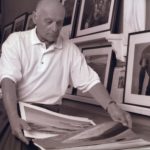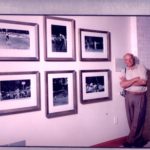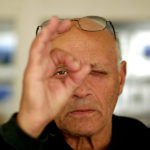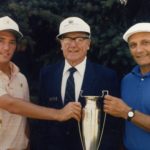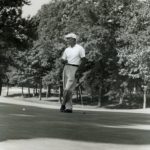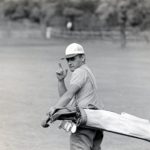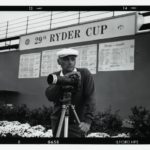
Jules Alexander (2020)
About Jules Alexander (2020)
His father gave him his first camera in 1938 when he was 12. By the time he was fifteen he had sold photos of Benny Goodman, Duke Ellington, and Frank Sinatra to Down Beat Magazine. At 18 he joined the Navy and did aerial reconnaissance photography in the South Pacific at the height of World War II. Returning to civilian life, he became a top commercial and fashion photographer in New York, his hometown. His subjects ranged from fishermen in Tokyo Bay to Grace Kelly at the NY Public Library, from laborers in a tunnel to JFK on the campaign trail.
But it was golf that gave Jules Alexander his greatest fame, and his golf photography that earned him a place in the MGA Hall of Merit.
He was already a golfer when he strolled out onto the grounds of Winged Foot in June 1959, cameras in hand. (He always had a camera with him in case he saw something interesting, “like a UFO,” he told Adam Schupak.) He had no assignment, and had never photographed golf before, but he thought it likely he’d find some worthy subjects during a practice round before the U.S. Open. What he found was Ben Hogan, and the unspoken communion between icon and lens changed Alexander’s life.
The most famous image of Hogan that actually shows his face – in contrast to Hy Peskin’s shot from behind Hogan’s approach to the 72nd green at Merion in 1950 – is probably Alexander’s photo known as “Alone on the Green,” taken during one of those practice rounds. Hogan’s legs are crossed, he is leaning on his putter, and he is looking in profile at something out of the frame (his playing partner and friend Claude Harmon). The crease in his trousers is perfect, the white shirt and peaked cap are classics. Alexander told Golf Digest in 2006 that Hogan appeared to hold still long enough for him to capture the look: “I’m going to have the temerity to think that he posed for me by saying to himself, ‘I’m gonna give this guy a shot.’”
The portfolio of images from that week of Hogan on the range and on the course are still the best record of the man’s technique, even though the Texan was 47 and several years removed from his last U.S. Open win. Though not exactly aloof – not yet – the golfer was famously uncooperative with photographers hoping to capture his secret; Alexander caught him at the right time and in the right place, and had the skill to meet the moment when the opportunity arose. Hogan’s equipment company used Alexander’s photos from that week for years, and they were collected in a volume called The Hogan Mystique published thirty-five years after they were taken.
In a way, Hogan captured Alexander, too. He was already a fan, having read Hogan’s 1948 book Power Golf and talked about it with his friends during rounds at Moshulu Golf Course in the Bronx. But now golf advanced from a pleasure to a passion for the photographer: he purchased a home in Rye, N.Y., at one end of the driving range at Westchester Country Club; he got his handicap down into single digits, and played avidly well into his 80s; he transmitted that love of the game to his sons Paul and Carl, who are today the head golf professional at Oak Hills Golf Course in Norwalk, Conn., and the director of golf at the Golf Club of Purchase, respectively. He even started wearing a Hogan-style cap.
“He was the biggest Ben Hogan fan you’d ever meet,” says Carl. “Many of the professionals playing in the [Manufacturers Hanover] tournament [at Westchester CC] would come over to the house to see the photos of Ben Hogan and talk about them. Gary Player, Dr. Gil Morgan, Peter Jacobsen, Chip Beck… We would sit around and talk about the golf swing every year as they marveled at the photos.”
The brothers attended the tournament each year beginning in 1970 and on through high school; they caddied in the pro-am and met and watched players like Nicklaus, Watson, Seve, Norman, and on and on. They traveled with Jules to tournaments around the country and carried his extra cameras, lenses, and equipment as they walked the courses with him. It was an ideal education for a golf pro-to-be, and they also absorbed the lessons he taught by example – because there have been few people so universally liked and admired in any field as Jules Alexander.
Alexander died in August 2016, a few months after celebrating his 90th birthday. Among his many other contributions to golf in the Met Area, he shot Nicklaus, Trevino, Palmer, and Player together – a first — for the cover of this magazine in TKTK. A companion piece of sorts to his Hogan book, Tiger Woods in Black & White, was published in 2008. It’s unsurprising that the kind soul with his camera always ready would produce such defining images of two of golf’s most elusive immortals. “My dad taught us a lot about being good to people and sharing your time,” Carl told Mike Daugherty. “I think it’s why he liked golf so much, because it provided an opportunity to get to know people.”
Photos shared courtesy of Carl Alexander.
Leaving His Mark on the Met Area…
Alexander’s golf photography career began at Winged Foot at the 1959 U.S. Open, and later took him all over the world. He called the Met Area home and was a longtime member at Westchester Country Club, where a gallery of his photos are on display.
ADDITIONAL DETAILS & MULTIMEDIA
Life Events
- Date of Birth: 1926
- Date of Death: August 2016 (Age 90)
Achievements
- A permanent exhibition is at The World Golf Village in St. Augustine, Florida
- An exhibition is on display at Golf House in Far Hills, New Jersey
- “Lincoln Werden Award for Outstanding Contributions to Golf Journalism.” June, 1999

